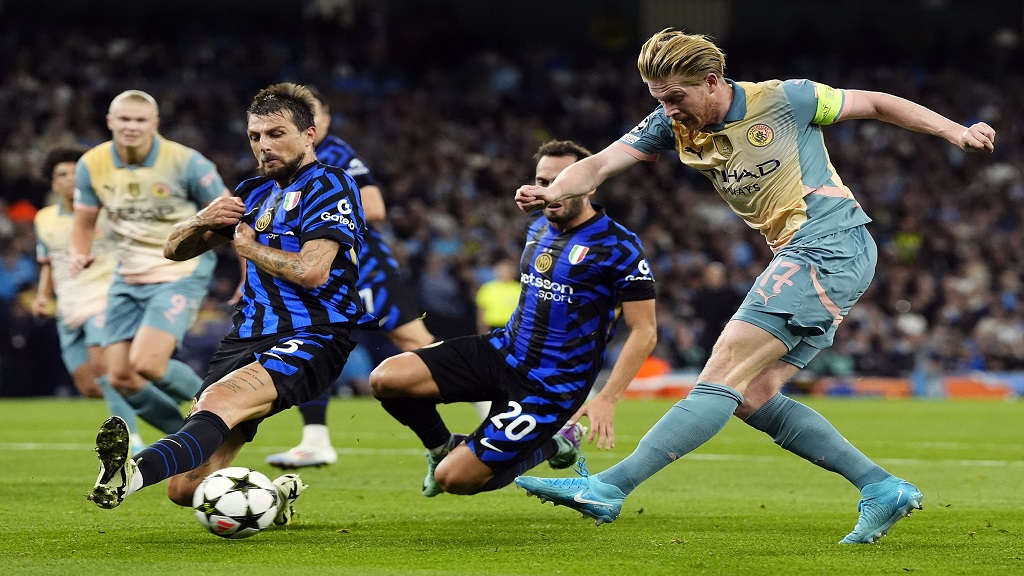European club soccer’s most competitive competition returned for the 2024–2025 season on Tuesday in an all-new league format that completely shakes up its structure. The Union of European Football Associations’ Champions League brings top clubs across Europe’s soccer leagues — such as England’s Premier League, France’s Ligue 1, and Italy’s Serie A — to vie for the title, a trophy that essentially cements a club as the best in Europe.
Teams that would otherwise not face each other are given the chance to cross borders and play some of the most anticipated fixtures, such as German giants FC Bayern Munich and storied Spaniards Real Madrid CF. The Champions League coincides with the countries’ national leagues, resulting in international club matches being played within the same timeframe as respective national leagues. Essentially, between the national leagues, the Champions League, and UEFA’s two other lower European leagues — the Europa League and the Conference League, clubs are playing a lot of matches.
Now, as UEFA implements historic changes for their international leagues for the 2024–2025 season, the way clubs compete is entirely new. For most, this is beckoning in an exciting and refreshing new era to an already beloved spectacle. For others, however, there is grounded concern over UEFA’s choices.
UEFA commenced the modern competition now known as the Champions League in 1992, after a major overhaul of the game’s old European Cup knockout structure that first took place in the 1950s.
The modern first-tier league was formatted to accommodate 32 teams, each placed into eight different groups of four in what was known as the group stage. Groups were structured as a miniature league, with teams earning points based on their wins, losses, or draws. Each team faced off the other three clubs in their group both home and away to total six matches, and the top two in each group would move on from the group stage to the knockout stage. The knockout stage sees clubs playing two-leg fixtures — home and away — in the round of 16, quarter-finals, and semi-finals stages, and concludes with a single fixture of the two finalists at a predetermined stadium. While this format is more closed off in terms of how many different teams would play one another, the format was unique from national league formats.
UEFA’s second-tier Europa League and third-tier Conference League also both followed this format, as both leagues contained different clubs that placed lower in their national leagues, and both similarly were changed this year.
What did UEFA do to completely dismantle this structure and reformat its international leagues? In consultation with various club executives and through a long consideration process, UEFA unveiled a new 36-team league format in summer 2024 that places all clubs into the same initial group as opposed to a series of smaller groups. Each club is seeded into one of four pots, sorted by the club’s UEFA coefficient ranking; this ensures that clubs are able to compete against others of varying difficulty levels in the league stage. Then, each club is drawn at random to play against two clubs from each pot, resulting in a total of eight matches for each club.
This change in play eliminates two-leg fixtures — home and away — and simultaneously adds two more games to a club’s league stage matches, resulting in more games and a greater variety in opponents. After the dust settles and the league stage matches are completed, the top eight on the table earn an automatic spot for the round of 16. The ninth- to 24th-placed teams will have to vie for the final eight spots, where ninth through 16th places will face off one team of the 17th through 24th places in a two-legged endeavor. Teams placed 25th to 36th are then outright eliminated from the tournament for the season.
Once all teams are then situated for the round of 16, the top eight teams will face off against the bottom eight teams, which will be determined by each team’s initial league phase rankings to assure fairer pairings. After these matches are determined, the rest of the tournament will proceed as normally structured, sticking to the original format of the knockout stage.
Ultimately, the teams placed in the middle of the league phase will have to play two extra games to advance, in addition to the already additional two extra games in the new league phase. UEFA’s restructuring choices for their leagues allow for greater competition, as this is naturally less restrictive than a group stage format, but at the same time are forcing clubs to play more matches in addition to their already rather busy competition schedules.
A major concern that has been voiced about this change is regarding the players themselves. For even greater context, UEFA league games are played in parallel with the normal soccer season in Europe, meaning that with more UEFA games, there is a shorter break between each match — sometimes only three days.
Not only are national league matches occurring within each country, but typically the country’s domestic cup between its varying levels of play is also occurring, such as England’s FA Cup or Germany’s DFB-Pokal. Additionally, when the national leagues have pauses in their season, the gaps are taken up by international competition, typically for the following summer’s competition.
This past year, summer Euro 2024 and 2024 Copa America qualifying matches were played between countries spaced throughout the course of the 2023–2024 season. For example, French forward Antoinne Griezmann of Club Atlético de Madrid would play upwards of 50 matches for his club in Spain’s La Liga, the Champions League, and Spain’s Copa del Rey per season. When not striking for his club, Griezmann vice-captains the French national team, meaning even during a break from his club duties, Griezmann is donning the national badge and performing in qualifying matches; last year it was for UEFA’s summer Euro 2024, and this year it is for the summer 2025 UEFA Nations League.
Now, as UEFA restructures the Champions League, Griezmann will already be playing more matches, which raises one of the most prevalent concerns in soccer: is it safe for the players?
There is already a running joke among fans that the international break ought to be colloquially termed the “injury” break, as it seems that players tend to pick up more injuries due to the lack of break from play, resulting in large impacts for teams as they head deeper into the season.
A prominent and very recent example rests with Arsenal, as captain Martin Ødegaard, Kieran Tierney, and Riccardo Calafiori were left off of the squad for Sunday’s North London Derby victory against the Tottenham Hotspurs due to injuries they received while playing for their respective national teams. Thierry Henry — Arsenal attacking legend, French Olympic soccer team coach, and current soccer pundit for CBS —has raised these concerns following UEFA’s announcement of changes, as the Daily Mail reported.
“I think for us, for CBS, it’s just outstanding — more games, to be able to talk about more games,” he said. “But there is a ‘but’ for me, because I’m going to go on the side of being a coach: too many games, too many games. [As] an ex-player I don’t know how those guys do it. As a pundit, I love it, but as an ex-player and as a coach, it’s too many games,” Henry said.
As the Champions League kicks off its new league format, the implications of more games for players will come to light as the season progresses. For now, fans, including myself, will enjoy a larger variety of opponents, a greater number of games, and higher stakes for points in club soccer’s most exciting tournament of the season.










